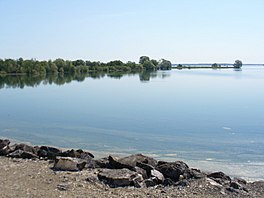geo.wikisort.org - Reservoir
Lake Der-Chantecoq (French: Lac du Der-Chantecoq) is situated close to the commune of Saint-Dizier in the departments of Marne and Haute-Marne. It is the largest artificial lake in France,[1] covering 48 km2 (19 sq mi) with 350 million m³ of water. The lake is named after the Der plain, in which it is located, and the submerged village Chantecoq.
| Lake Der-Chantecoq Lac du Der-Chantecoq | |
|---|---|
 | |
| Location | Champagne-Ardenne |
| Coordinates | 48°34′57″N 4°45′33″E |
| Type | artificial lake |
| Primary inflows | Marne |
| Primary outflows | Marne |
| Catchment area | 2,900 km2 (1,100 sq mi) |
| Basin countries | France |
| Surface area | 48 km2 (19 sq mi) |
| Max. depth | 15 m (49 ft) |
| Water volume | 350 hm3 (280,000 acre⋅ft) |
| Settlements | Sainte-Marie-du-Lac-Nuisement, Giffaumont-Champaubert |
The lake is fed by a 12 km long canal that branches off the river Marne in Saint-Dizier. The outflow of the lake is a canal that joins the Marne in Arrigny, 20 km downstream of Saint-Dizier. The lake is located in the communes (clockwise starting from the north) Sainte-Marie-du-Lac-Nuisement, Éclaron-Braucourt-Sainte-Livière, Giffaumont-Champaubert, Arrigny, Larzicourt and Écollemont.
History
It was created in 1974 to hold the water of the river Marne so that flooding of the Seine at Paris would stop. It is managed by Les Grands Lacs de Seine. Its construction required the destruction of three villages; Chantecoq (Marne), Champaubert-aux-Bois and Nuisement-aux-Bois.
Today, many water sports are popular here, including sailing, water skiing, jet-ski, wind surfing, fishing, rowing etc. as well as walking, rollerblading and cycling around its edges.[2]
Flora and fauna
The combination of deep water, islands, and freshwater marshes make the area ideal for waterfowl, most notably the common crane. Each spring and autumn, tens of thousands of cranes assemble here in their migration between wintering grounds to the south and breeding sites in northern Europe. Other birds recorded in the area include white-tailed eagle, great egret, and various geese, ducks, loons (divers), and grebes. The surrounding area is rural, a region of farmland and forest.[3]
- Lake Der-Chantecoq
- A church at Châtillon-sur-Broué
- A house at Châtillon-sur-Broué
References
- "Le lac du Der-Chantecoq". champagne-ardenne.lpo.fr (in French). Retrieved 2020-05-29.
- "Institution Interdépartementale des Barrages-Réservoirs du Bassin de la Seine". Archived from the original on June 1, 2009. Retrieved 13 September 2009.
- Couzens, Dominic (2008). Top 100 Birding Sites of the World. University of California Press. pp. 25–26. ISBN 978-0-520-25932-4.
External links
| Wikimedia Commons has media related to Lac du Der-Chantecoq. |
- Lac du Der en Champagne
- (in French) Yaughting Club du Der
- (in French) Club Nautique
На других языках
[de] Lac du Der-Chantecoq
Der Lac du Der-Chantecoq (kurz Lac du Der; Marne-Stausee) liegt in der südlichen Champagne, in der Region Grand Est und ist mit knapp 48 km² der größte Stausee in Frankreich, der bei Wassersportlern wie bei Naturfreunden wegen seiner Lage im dünn besiedelten Nordosten Frankreichs bekannt ist.- [en] Lake Der-Chantecoq
[es] Lago del Der-Chantecoq
El lago del Der-Chantecoq (en francés, lac du Der-Chantecoq) es un lago artificial situado cerca de las ciudades de Saint-Dizier y Vitry-le-François, entre las departamentos de la Marne y de la Haute-Marne.[fr] Lac du Der-Chantecoq
Le lac du Der-Chantecoq ou lac-réservoir Marne (souvent abrégé en lac du Der) est un lac du Nord-Est de la France. Il est situé dans la région Grand Est, à la limite des départements de la Marne et de la Haute-Marne.[ru] Дер-Шантекок
Дер-Шантекок (фр. Lac du Der-Chantecoq) — самое большое водохранилище в Западной Европе[1], площадью 48 км². Названо в честь долины Дер, в которой расположено, и затопленной деревни Шантекок. Наибольшая глубина — 15 м[источник не указан 782 дня].Другой контент может иметь иную лицензию. Перед использованием материалов сайта WikiSort.org внимательно изучите правила лицензирования конкретных элементов наполнения сайта.
WikiSort.org - проект по пересортировке и дополнению контента Википедии



